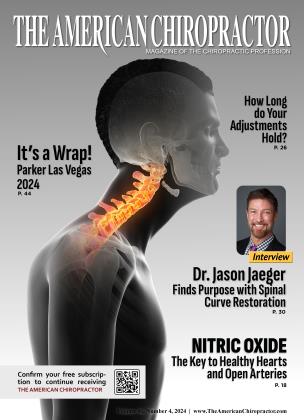Professional Upgrade
By Alan Cook, DC
“What you do today can improve all your tomorrows.” ~ Ralph Marston
Change is occurring, with more to come. The chiropractic profession, like any life form, must adapt; failing to do so risks extinction.
An unfortunate historical bias has limited the chiropractic profession. Many settings where chiropractors would be able to contribute have been constrained. The same was true for other health providers.
The strategy used by physical therapists, physician assistants, and nurse practitioners to expand their privileges, compensation, and recognition was to increase their education. Educational advancements were instituted and then broadcast, leading to tangibly beneficial acknowledgments.
As the competitive healthcare market and the body of knowledge expands, so must educational efforts. Parallel strategies are needed for our profession’s upgrade.
The quantity and quality of accredited continuing education must increase. In regard to quantity, our profession should have similar requirements to other providers. This, in turn, bolsters our position for parity, inclusion, and expanded privileges (e.g., Medicare) to equal our scope of practice.
Provider | Continuing education requirement (California 2023) |
Physician assistants | 100 hours/2 years |
Nurse practitioners | 30 hours/2 years |
Medical doctors/Osteopathic doctors | 50 hours/2 years |
Physical therapists | 30 hours/2 years |
Doctors of chiropractic | 24 hours/1 year * (requirements vary by state and country) |
In attending continuing education courses for 34 years, some have been excellent and some dismal. Many of the low-quality courses are attributable to the speaker having no enhanced knowledge but rather a few sound bites of information and lots of fluff. Our state boards offer little quality control. If a non-chiropractic provider attended, our profession would be rightly embarrassed for what was pretending to be education.
An adaptation to reduce the possibility of accrediting a low-quality speaker is to require publication as a primary author in an indexed journal (e.g., articles in journals on PubMed) within the past 10 years. All indexed journals have a qualified editorial board and editors. Articles submitted must be of a rigorous standard to be accepted for publication. Although an argument can be made for more than one publication per decade, this requirement represents a genuine step up and will eliminate current speakers unable to demonstrate their knowledge.
The editors and blinded peer-reviewers function as independent, unbiased parties for those who have submitted a manuscript of high quality to merit publication and, in turn, allow for speaker accreditation. The state/national boards would only need to confirm the speakers’ submitted citations; no new infrastructure would be needed.
An additional benefit of speaker accreditation via publication is that more articles would be submitted to our journals, which raises the profile of the profession. Without publication, we are invisible and ignored because expertise is often equated with contributions to literature.
The suggested adaptations could be phased in over five years, which is more than ample time for boards, speakers, and practicing DCs to institute the necessary changes. For perspective, career researchers can publish five to 10 papers per year.
Observations and opinions:
The chiropractic profession needs to demonstrate that our education is equal to or greater than all licensed healthcare providers.
That requires an education upgrade as well as field doctors interfacing with the research community (such as MD/DO hospital programs).
Our universities are adapting, but this leaves out those already in practice.
Continuing education (CE) units are minimally regulated. Quality control does not exist.
Our current CE instructors are not required to demonstrate exceptional knowledge; most are unpublished because they don’t have to be.
The requirement of publication in an indexed journal would mean that instructors have to be aware of the literature.
A profession-wide educational upgrade would provide:
More informed continuing education instructors.
Field doctors receiving better information.
Increased interactions with other health professionals.
An increase in the number of high-quality published manuscripts in our indexed journals.
In this competitive world, the chiropractic profession needs to upgrade our education and performance to expand our access to the broader healthcare system and increase our privileges, which will result in greater interprofessional recognition and compensation parity. A greater professional profile and acknowledgment must be earned. No one will give it to us.
About the Author
Alan Cook, DC, has been in practice since 1989. He ran the Osteoporosis Diagnostic Center (1996 to 2019), participated in four clinical trials, and lectured nationally. He is enjoying semiretirement and providing video-based continuing education with EasyWebCE.
To see more of his work, visit www.EasyWebCE.com.
 View Full Issue
View Full Issue






